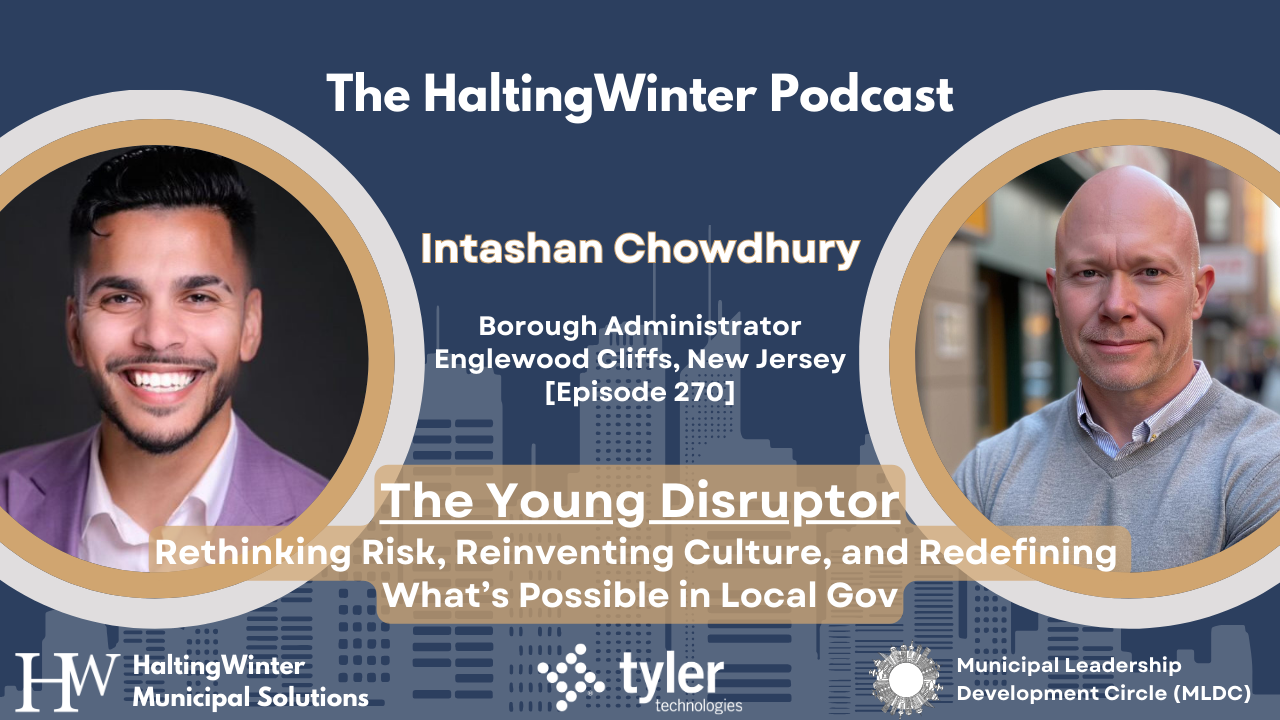Municipal Leaders: Develop Faster, Lead Stronger, Build Better

Every week, you’ll get insights and actionable steps to help you navigate personal growth and professional success.

Episode 275 of The HaltingWinter Podcast
Brought to you by Tyler Technologies
Municipal leadership has a way of convincing people they’re supposed to carry it all by themselves.
The pressure doesn’t shut off.
The criticism doesn’t always make sense.
And the responsibility—financial, organizational, human—never really leaves your shoulders.

A Reconnect with David Cameron on Mental Health and Municipal Leadership
Episode 274 of The HaltingWinter Podcast
Brought to you by Tyler Technologies
Some leadership stories deserve to be revisited, not because they were successful, but because they were honest.
David Cameron was the very first full-length local government leader interviewed on The HaltingWinter Podcast (Episode 107). At the time, he was City Administrator in Republic, Missouri. Today, he serves as City Manager of Springfield, Missouri, leading a city of more than 170,000 residents and a workforce of over 2,200 employees.
In this Reconnect episode, David and host Seth Winterhalter sit down for a candid conversation before replaying the original interview, one that goes deeper into the reality many leaders quietly live with.

Some leadership decisions only make sense years down the road.
Unfortunately, the criticism shows up immediately.
In Episode 273 of The HaltingWinter Podcast, I reconnect with Bret Prebula, City Manager of Suisun City, California, before replaying one of the most impactful conversations we’ve ever shared on the show.

The future of local government won’t be shaped by policy alone. It will be shaped by people and by whether the next generation sees city management as a calling worth stepping into.
In Episode 272 of The HaltingWinter Podcast, Seth sits down with Max Fisher, an MPA student and Assistant to the City Manager’s Office in Levelland, Texas, whose journey into local government offers a powerful mirror for today’s leaders.

You know that situation you’re facing right now? The one that feels impossible?
What if the problem isn’t the situation itself, but the story you’re telling yourself about it?


Episode 270 of The HaltingWinter Podcast
Brought to you by Tyler Technologies
Every so often, someone enters the local government arena who refuses to accept the quiet limitations we’ve all inherited—constraints around risk, innovation, culture, and what a “small city” is allowed to become.
Intashan Chowdhury is one of those leaders.

Episode 269 of The HaltingWinter Podcast
Brought to you by Tyler Technologies
Most people outside city hall never see the tension local government leaders carry. They don’t see the governance dynamics behind the scenes, the pressure to deliver services with limited resources, the weight of decisions that shape lives and neighborhoods for decades.
But every so often, a conversation cuts through the noise and reminds us what this work is really about.
Episode 269 is one of those conversations.

You’ve earned the promotions. Built the resume. Gained the respect. Checked all the boxes.
So why does something still feel missing?
This week in the Municipal Leadership Development Circle (MLDC), we’re exploring David Brooks’ The Second Mountain, a book that puts words to what many accomplished local government leaders are feeling but can’t quite articulate.

Episode 267 of The HaltingWinter Podcast
Brought to you by Tyler Technologies
Some cities live at a steady hum. Carbondale, Illinois, often lives at full volume.
With a major university, a long history of activism, and national issues regularly surfacing on local streets, Carbondale is one of those rare communities where protests, politics, and public pressure are part of the weekly rhythm. And for City Manager Stan Reno, that’s not a crisis — it’s the calling.

Episode 266 of The HaltingWinter Podcast
Brought to you by Tyler Technologies
Most people spend their careers trying to avoid storms.
City managers don’t get that luxury.
In this week’s episode of The HaltingWinter Podcast, I talk with Rebecca Grill, City Manager of Oshkosh, Wisconsin, a leader whose entire career has been shaped by one defining principle:
When the storm forms, don’t wait for it to pass. Run toward it.